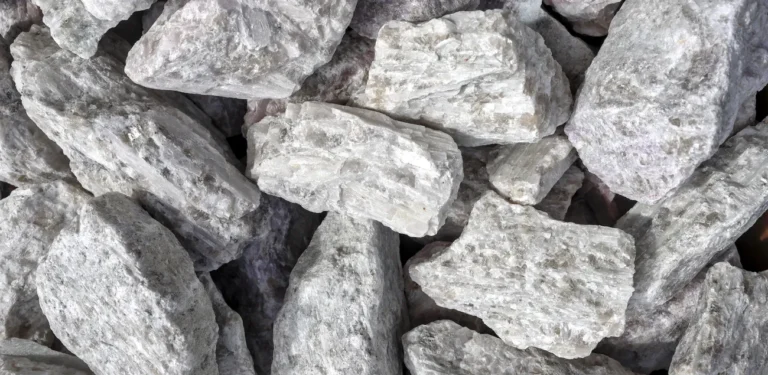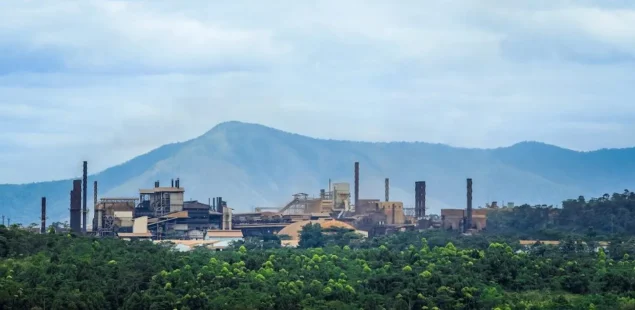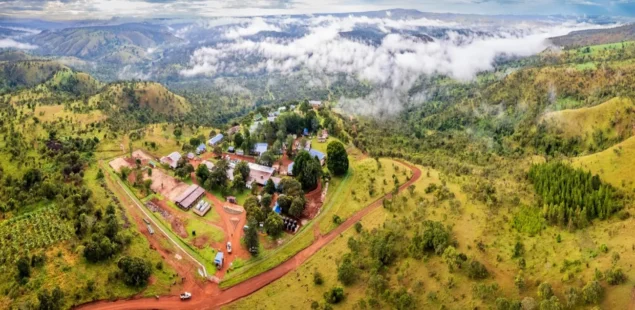
Indonesian authorities withdrew four of five nickel concessions in Raja Ampat, Western Papua province, after mass environmental activism that drew international scrutiny for one of Earth’s most richest marine habitats. It followed after international interest that had turned toward Papua mining operations upon the island chain that’s chock full of coral, which harbors 75 percent of Earth’s coral species and which draws tourists on diving trips.
Energy and Mineral Resources Ministry minister Bahlil Lahadalia clarified on June 10 that permits of PT Anugerah Surya Pratama, PT Kawei Sejahtera Mining, PT Mulia Raymond Perkasa, and PT Nurham would have their permits cancelled. Only one company, subsidiary-state Aneka Tambang’s PT Gag Nikel, was allowed to retain its permit so that it can continue operations on Gag Island, which falls outside of the perimeter of the geopark that has protected status under UNESCO.
Global Outry Over Greenpeace’s Campaign
Controversy broke out in May 2025 after a video investigation by Greenpeace Indonesia documented nickel mining’s effects on three islands off Raja Ampat: Gag, Kawe, and Manuran. It continued when, on June 3rd, group activists, also accompanied by four Raja Ampat youth, staged a silent vigil at the Indonesia Critical Minerals Conference in Jakarta.
Anti-mining activists held signs that read “What’s the Real Price of Your Nickel?” and “Nickel Mines Ruin Lives” when they disrupted a seminar, which featured Deputy Foreign Affairs Ministry official Arief Havas Oegroseno speaking to mining company executives. It elicited mass social media activism, under the #SaveRajaAmpat hashtag, after tens of thousands of Indonesians posted photos and videos documenting mining degradation throughout the region.
Ronisel Mambrasar, one of Raja Ampat Nature Guardians coalition’s youth, proclaimed in action: “Raja Ampat faces severe threat because there are nickel mines in some islands, for example, my island, Manyaifun, and Batang Pele islands. My existence also faces threat due to nickel mining”.
Environmental Degradation and Law Breaches
Government investigations discovered several environmental breaches conducted by mining operations. It came to light after investigations conducted by the Ministry of Environment that at least three had breached environmental law, including failure to operate under pertinent licenses and causing environmental impacts including sedimentation and invasion of forests. Investigations conducted by Greenpeace found that nickel mining had consequently cleared more than 500 hectares of forests and indigenous vegetation that span across the three islands.
The mining activities are a straight violation of Indonesia’s law of 2014 on management of small islands and coasts, which bans mining activities in small islands that are below 2,000 square kilometers in area. Nothing but conservation, education, research, marine cultivation, tourism, fisheries, organic farming, and national defence operations are allowed in small islands. Raja Ampat’s majority of mining activities are done in islands that are only 60 square kilometres in area.
Excavation and clearing have caused soil runoff that leads to turbidity and sedimentation in marine water, which directly jeopardize Raja Ampat marine habitats and coral reef systems. Dr. Phillip Dustan, marine biologist who has studied coral reef systems like Raja Ampat since the 1970s, conducted research at Raja Ampat and his description of effects there were: “When you go into a nickel mine and you scrape off the top layer, the system bleeds. It not only bleeds sediment, but it also bleeds all the nutrients that are in the biomass”
Nickel Stockpiles and Production Scale Size
A 2022 study conducted by the Ministry of Energy and Mineral Resources estimated Raja Ampat’s reserve to be at 482 million tonnes of nickel ore beneath its surface. It’s a phenomenal reserve when measured next to Indonesia’s 2023 production of 137.8 million tonnes of nickel ore, which happened to be Indonesia’s highest year of nickel mining industries production.
There’s no place that’s expanded its nickel operations more aggressively to feed global electric vehicle battery production, leaping in a single decade to 27 functioning plants today, and 22 under construction. Indonesia today produces more than half of all nickel mined globally, and it’s becoming increasingly essential in the battery supply chain. Indonesian nickel production has doubled more than twice since 2019, to 2.2 million tonnes per year, compared to 800,000 tonnes per year.
Division of Society and Social Effect
Mining operations have caused sharp divisions among Raja Ampat people. On one hand, there are people who are benefiting financially through mining employment and remuneration by mining operations, but, conversely, there are people who are relying on tourism and fisheries, which are threatened by environmental degradation. Livelihoods that are dependent on fishing and ecotourism are at risk, which leaves people economically vulnerable and reliant on precarious mining employment.
Local indigenous people have argued that they have had their indigenous right of free, prior, and informed consent of mining operations on their ancestral domains stripped away. Mining operations have also been accused of bribing people to gain their consent while their opponents have been threatened and isolated. On Manuran Island, mining operations carried out by PT Anugerah Surya Pratama have actually plucked individual plumes dispersing all the way throughout their community when high tide occurs.
Response of Government and Current Issues
The permit revocations came after Minister Bahlil Lahadalia visited the region in June 2025 and was met with massive protests at Sorong Airport, forcing him to exit through a back door to avoid demonstrators demanding immediate revocation of all mining permits. The government cited the need to protect Raja Ampat as a world-class tourist attraction and preserve its sustainability.
There are, nevertheless, also concerns that this decision will be reversed because there will inevitably be litigation by mining companies. Greenpeace Indonesia demands that all of Raja Ampat be strictly protected, including the revocation of all mining concessions, inactive or active. Representatives of the organization explained that cancelled mining permits were reissued in the region after campaigns and litigations by mining companies.
Regional Location and Tourism Effect
Raja Ampat covers about 20,000 square kilometres and comprises marine protected areas that are managed through Ministry of Marine Affairs and Fisheries. It’s also a UNESCO World Geopark and its unique terrestrial and marine biology are well recognized, comprizing 47 species of mammals, 274 types of birds, and more than 2,500 species of fish.
Regional tourism, based on diving and marine resources conservation, faces direct threat from extractive industries. Province of Southwest Papua Governor Elisa Kambu insisted that Raja Ampat should continue to head towards marine conservation area and Indonesia’s top tourism destination, but “this orientation cannot be allowed to compromise mining operations”
About Company and Market
PT Gag Nikel, the only mining company that has permission to operate in Raja Ampat, has a concession covering 130 square kilometers, and in 2024, it had approximately 3 million tonnes of nickel production. It should maintain that production until 2026 despite stoppage orders that were put in place when there were protests. Gag Nikel began their operations in Raja Ampat in 1967 when they began exploration, and they have had continued presence until production in 2018.
Other companies that were involved in their licenses being cancelled were PT Anugerah Surya Pratama, which belongs to China-operated firm PT Wanxiang Nickel Indonesia group, and had one nickel smelter plant in Central Sulawesi province. It had one concession covering 1,173 hectares on Manuran Island, which had only 746 hectares, so much of that concession included peripheral waters. Such increases in Indonesian nickel production are evident in world demand for electric auto battery manufacturing and stainless manufacturing. Indonesias nickel ore reserve deposits are largest in the world, and successive governments have assured them of making Indonesia a world capital of electric auto manufacturing. But environmental NGOs counter that nickel industrialization push has harmed more than it has helped in implementing the energy transition to renewables, frequently ruining environments and abusing indigenous people’s rights while accelerating climate destruction.



